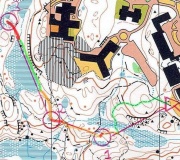Traffic light orienteering - theoretical
From O-training.net
Orienteering Exercise: Traffic light orienteering - theoretical
Key information
Pick a course, and draw your planned route in three colors: Green for the parts where you can run without much attention to the map, orange for parts where you have to give some attention to the map and red for the parts where you have to put a lot of attention to the orienteering (e.g. probably slow down significantly, based on your technique). You can also continue with a practical part in which you run the same course either on the map with your planned colorful route drawn, or on a map without planned route.
The theoretical can be skipped.
| Aim: | The aim of the exercise is to understand the need to adapt your speed to the difficulties, and figure out in which part of the course you have to pay attention to the orienteering, and why. It is important to focus both on the areas where you can increase your speed (think simplification) and the areas where you must decrease your speed (due to difficult orienteering). |
|---|---|
| Variants: | You can continue with a practical part (see Traffic light orienteering)in which you run the same course either on the map with your planned colorful route drawn, or on a map without planned route. |
| Aids: | None required. |
| Terrain: | Any map/terrain will do. |
| Preparations: | Pick a course and get started. If you are doing only the theoretical exercise, you can take any course, e.g. one from a World Orienteering Championship. |
| Tips: | You learn most if you run the course afterwards. Your work after the training analyzing your training and comparing with the colorful route you drew before the training is the most valuable part of the training. |
| Examples: |
Please Log in to contribute to O-training.net
O-training.net Blog articles:
- WOC Sprint Relay 2015: BIG GPS & Splits Analysis
- World Cup Long Spain: Quick GPS analysis
- WinSplits Pro for Iphone: Quick Review
- Gueorgiou: How to master the compass
- HeadCam analysis with local videos in 2DRerun
- What is effective technical training?
- RouteChoice Challenge: Long decisive leg in Swiss Champs Long
- WebRoute: Route choice leg Canada
- 2DRerun: Two very WOC Middle relevant races
- EOC Long Final: GPS Analysis
Useful links:
